Pathophysiology of Asthma and Clinical Manifestations: A Case Study
VerifiedAdded on 2023/04/21
|8
|1938
|93
AI Summary
This essay discusses the pathophysiology of asthma and the clinical manifestations of a case study. It explores the inflammation, airway obstruction, bronchial hyperresponsiveness, and bronchospasm associated with asthma. The case study focuses on a patient with expiratory wheeze, prolonged expiration, coughing, and a running nose. The severity of symptoms varies among individuals.
Contribute Materials
Your contribution can guide someone’s learning journey. Share your
documents today.
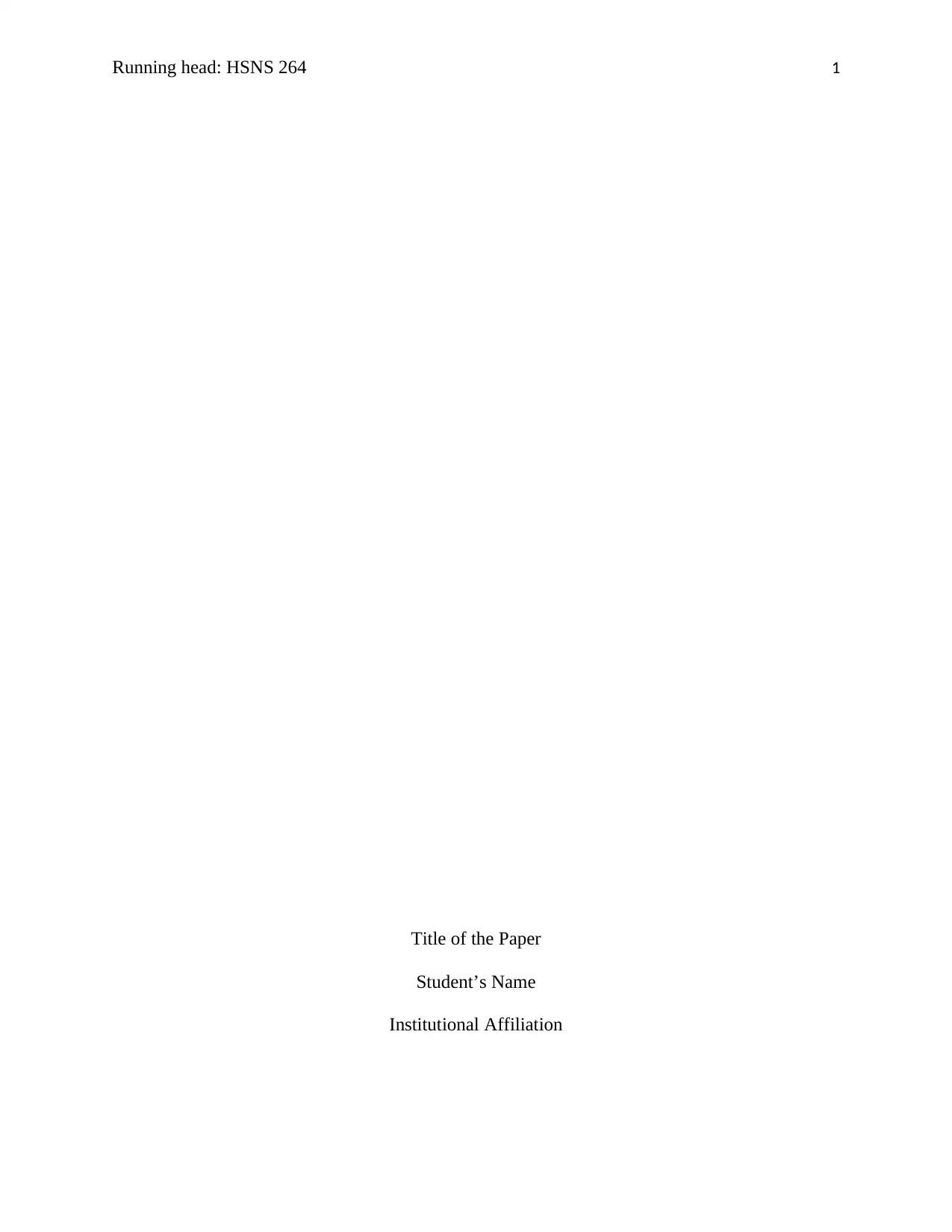
Running head: HSNS 264 1
Title of the Paper
Student’s Name
Institutional Affiliation
Title of the Paper
Student’s Name
Institutional Affiliation
Secure Best Marks with AI Grader
Need help grading? Try our AI Grader for instant feedback on your assignments.
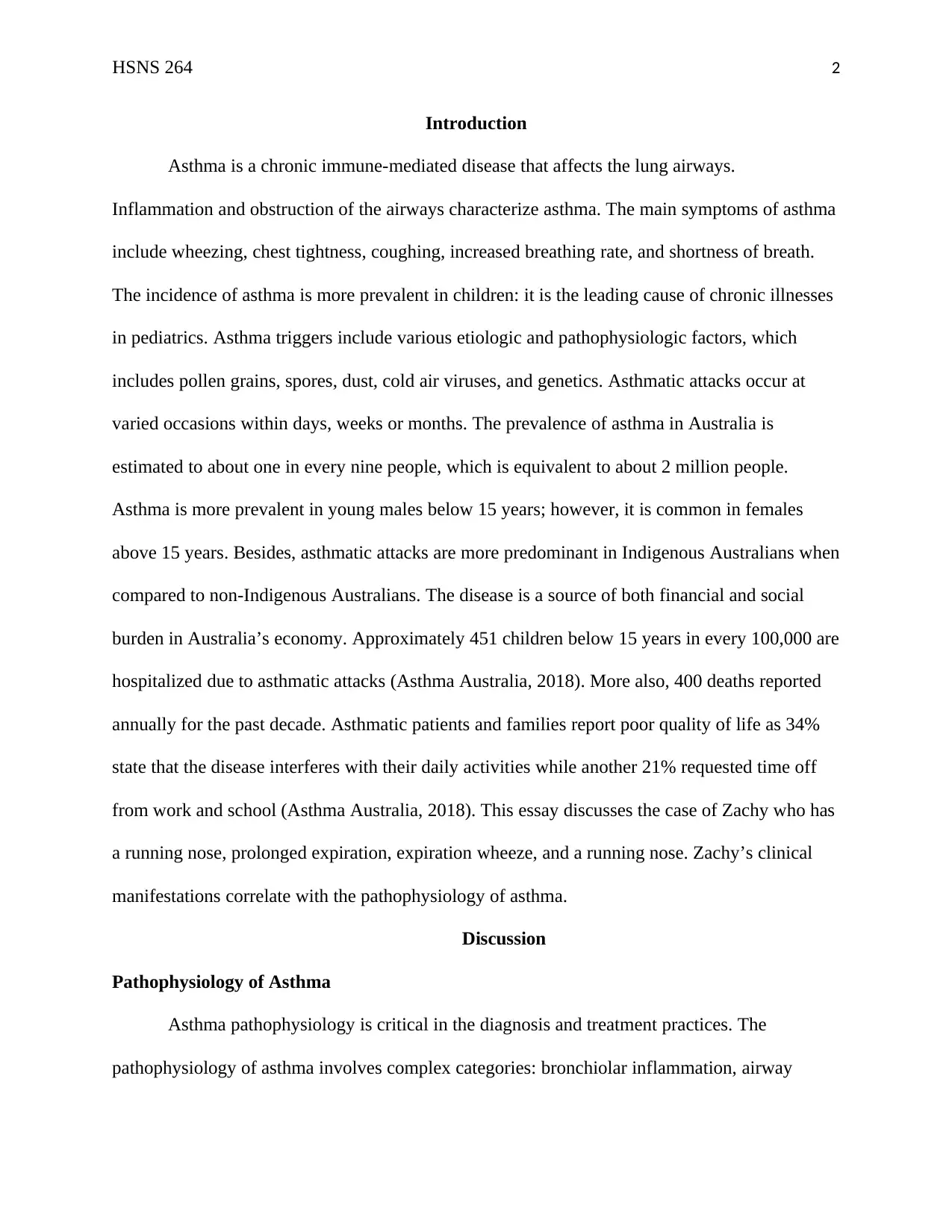
HSNS 264 2
Introduction
Asthma is a chronic immune-mediated disease that affects the lung airways.
Inflammation and obstruction of the airways characterize asthma. The main symptoms of asthma
include wheezing, chest tightness, coughing, increased breathing rate, and shortness of breath.
The incidence of asthma is more prevalent in children: it is the leading cause of chronic illnesses
in pediatrics. Asthma triggers include various etiologic and pathophysiologic factors, which
includes pollen grains, spores, dust, cold air viruses, and genetics. Asthmatic attacks occur at
varied occasions within days, weeks or months. The prevalence of asthma in Australia is
estimated to about one in every nine people, which is equivalent to about 2 million people.
Asthma is more prevalent in young males below 15 years; however, it is common in females
above 15 years. Besides, asthmatic attacks are more predominant in Indigenous Australians when
compared to non-Indigenous Australians. The disease is a source of both financial and social
burden in Australia’s economy. Approximately 451 children below 15 years in every 100,000 are
hospitalized due to asthmatic attacks (Asthma Australia, 2018). More also, 400 deaths reported
annually for the past decade. Asthmatic patients and families report poor quality of life as 34%
state that the disease interferes with their daily activities while another 21% requested time off
from work and school (Asthma Australia, 2018). This essay discusses the case of Zachy who has
a running nose, prolonged expiration, expiration wheeze, and a running nose. Zachy’s clinical
manifestations correlate with the pathophysiology of asthma.
Discussion
Pathophysiology of Asthma
Asthma pathophysiology is critical in the diagnosis and treatment practices. The
pathophysiology of asthma involves complex categories: bronchiolar inflammation, airway
Introduction
Asthma is a chronic immune-mediated disease that affects the lung airways.
Inflammation and obstruction of the airways characterize asthma. The main symptoms of asthma
include wheezing, chest tightness, coughing, increased breathing rate, and shortness of breath.
The incidence of asthma is more prevalent in children: it is the leading cause of chronic illnesses
in pediatrics. Asthma triggers include various etiologic and pathophysiologic factors, which
includes pollen grains, spores, dust, cold air viruses, and genetics. Asthmatic attacks occur at
varied occasions within days, weeks or months. The prevalence of asthma in Australia is
estimated to about one in every nine people, which is equivalent to about 2 million people.
Asthma is more prevalent in young males below 15 years; however, it is common in females
above 15 years. Besides, asthmatic attacks are more predominant in Indigenous Australians when
compared to non-Indigenous Australians. The disease is a source of both financial and social
burden in Australia’s economy. Approximately 451 children below 15 years in every 100,000 are
hospitalized due to asthmatic attacks (Asthma Australia, 2018). More also, 400 deaths reported
annually for the past decade. Asthmatic patients and families report poor quality of life as 34%
state that the disease interferes with their daily activities while another 21% requested time off
from work and school (Asthma Australia, 2018). This essay discusses the case of Zachy who has
a running nose, prolonged expiration, expiration wheeze, and a running nose. Zachy’s clinical
manifestations correlate with the pathophysiology of asthma.
Discussion
Pathophysiology of Asthma
Asthma pathophysiology is critical in the diagnosis and treatment practices. The
pathophysiology of asthma involves complex categories: bronchiolar inflammation, airway

HSNS 264 3
obstruction, and bronchial hyperresponsiveness (Mims, 2015). Asthma affects the trachea,
bronchioles, and bronchi. Inflammation may occur despite the absence of common signs and
symptoms. Cytokines and chemokines cause airway inflammation. Cytokines are produced by
various cells such as the mast cells and lymphocytes. T-helper lymphocytes produce cytokines
that trigger intense inflammation in allergic asthma incidents (Mitchelle & O’Byrne, 2017).
Chemokines recruit pro-inflammatory lymphocytes such as neutrophils, which have a distinct
role in the pathogenesis of asthma.
Bronchoconstriction arises due to muscle damage, edema, excessive mucus, and
bronchospasms. Bronchospasms are the sharp contraction of the bronchial smooth muscles,
which cause narrowing of the airways (Alfieri et al., 2014). Besides, edema that arises from
microvascular leakage contributes to the narrowness of the airways. More also, the dilation and
leakage from the airways capillaries cause edema that, in turn, hinders mucus clearance from the
lungs. Asthma expands the mucus-secreting glands, which increases the number of mucus-
secreting cells. Increased mucus secretions result in plugs that block the airways.
The airway epithelium is a target of infectious and environmental factors, which cause
injury through the influx of pro-inflammatory cells. Epithelium peeling due to injury causes
extreme airway impairment. The loss of the epithelium layer allows the penetration of allergens,
causing airway hyperresponsiveness. The extent of hyperresponsiveness is dependent on a
patient’s immunity and inflammation (Fraser et al., 2017). However, bronchodilator therapy is
ineffective in treating hyperresponsiveness; instead, anti-inflammatory medications are essential.
Asthma results in the loss of enzymes, which degrade inflammatory mediators. This is
due to subsequent reflexive neural effects relating to the exposure of sensory nerves. In the case
of improper treatment measures, asthma may result in airway remodeling. Airway remodeling
obstruction, and bronchial hyperresponsiveness (Mims, 2015). Asthma affects the trachea,
bronchioles, and bronchi. Inflammation may occur despite the absence of common signs and
symptoms. Cytokines and chemokines cause airway inflammation. Cytokines are produced by
various cells such as the mast cells and lymphocytes. T-helper lymphocytes produce cytokines
that trigger intense inflammation in allergic asthma incidents (Mitchelle & O’Byrne, 2017).
Chemokines recruit pro-inflammatory lymphocytes such as neutrophils, which have a distinct
role in the pathogenesis of asthma.
Bronchoconstriction arises due to muscle damage, edema, excessive mucus, and
bronchospasms. Bronchospasms are the sharp contraction of the bronchial smooth muscles,
which cause narrowing of the airways (Alfieri et al., 2014). Besides, edema that arises from
microvascular leakage contributes to the narrowness of the airways. More also, the dilation and
leakage from the airways capillaries cause edema that, in turn, hinders mucus clearance from the
lungs. Asthma expands the mucus-secreting glands, which increases the number of mucus-
secreting cells. Increased mucus secretions result in plugs that block the airways.
The airway epithelium is a target of infectious and environmental factors, which cause
injury through the influx of pro-inflammatory cells. Epithelium peeling due to injury causes
extreme airway impairment. The loss of the epithelium layer allows the penetration of allergens,
causing airway hyperresponsiveness. The extent of hyperresponsiveness is dependent on a
patient’s immunity and inflammation (Fraser et al., 2017). However, bronchodilator therapy is
ineffective in treating hyperresponsiveness; instead, anti-inflammatory medications are essential.
Asthma results in the loss of enzymes, which degrade inflammatory mediators. This is
due to subsequent reflexive neural effects relating to the exposure of sensory nerves. In the case
of improper treatment measures, asthma may result in airway remodeling. Airway remodeling
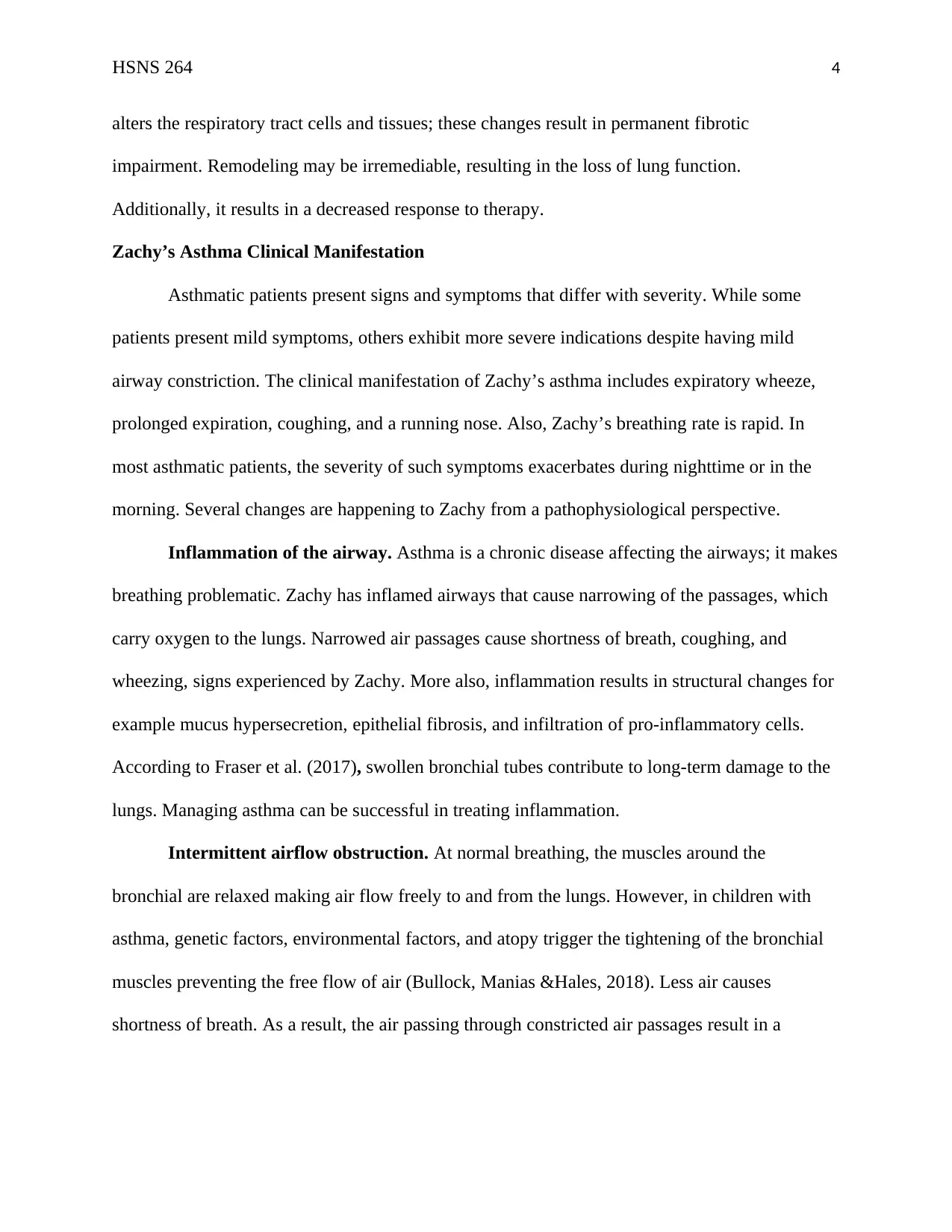
HSNS 264 4
alters the respiratory tract cells and tissues; these changes result in permanent fibrotic
impairment. Remodeling may be irremediable, resulting in the loss of lung function.
Additionally, it results in a decreased response to therapy.
Zachy’s Asthma Clinical Manifestation
Asthmatic patients present signs and symptoms that differ with severity. While some
patients present mild symptoms, others exhibit more severe indications despite having mild
airway constriction. The clinical manifestation of Zachy’s asthma includes expiratory wheeze,
prolonged expiration, coughing, and a running nose. Also, Zachy’s breathing rate is rapid. In
most asthmatic patients, the severity of such symptoms exacerbates during nighttime or in the
morning. Several changes are happening to Zachy from a pathophysiological perspective.
Inflammation of the airway. Asthma is a chronic disease affecting the airways; it makes
breathing problematic. Zachy has inflamed airways that cause narrowing of the passages, which
carry oxygen to the lungs. Narrowed air passages cause shortness of breath, coughing, and
wheezing, signs experienced by Zachy. More also, inflammation results in structural changes for
example mucus hypersecretion, epithelial fibrosis, and infiltration of pro-inflammatory cells.
According to Fraser et al. (2017), swollen bronchial tubes contribute to long-term damage to the
lungs. Managing asthma can be successful in treating inflammation.
Intermittent airflow obstruction. At normal breathing, the muscles around the
bronchial are relaxed making air flow freely to and from the lungs. However, in children with
asthma, genetic factors, environmental factors, and atopy trigger the tightening of the bronchial
muscles preventing the free flow of air (Bullock, Manias &Hales, 2018). Less air causes
shortness of breath. As a result, the air passing through constricted air passages result in a
alters the respiratory tract cells and tissues; these changes result in permanent fibrotic
impairment. Remodeling may be irremediable, resulting in the loss of lung function.
Additionally, it results in a decreased response to therapy.
Zachy’s Asthma Clinical Manifestation
Asthmatic patients present signs and symptoms that differ with severity. While some
patients present mild symptoms, others exhibit more severe indications despite having mild
airway constriction. The clinical manifestation of Zachy’s asthma includes expiratory wheeze,
prolonged expiration, coughing, and a running nose. Also, Zachy’s breathing rate is rapid. In
most asthmatic patients, the severity of such symptoms exacerbates during nighttime or in the
morning. Several changes are happening to Zachy from a pathophysiological perspective.
Inflammation of the airway. Asthma is a chronic disease affecting the airways; it makes
breathing problematic. Zachy has inflamed airways that cause narrowing of the passages, which
carry oxygen to the lungs. Narrowed air passages cause shortness of breath, coughing, and
wheezing, signs experienced by Zachy. More also, inflammation results in structural changes for
example mucus hypersecretion, epithelial fibrosis, and infiltration of pro-inflammatory cells.
According to Fraser et al. (2017), swollen bronchial tubes contribute to long-term damage to the
lungs. Managing asthma can be successful in treating inflammation.
Intermittent airflow obstruction. At normal breathing, the muscles around the
bronchial are relaxed making air flow freely to and from the lungs. However, in children with
asthma, genetic factors, environmental factors, and atopy trigger the tightening of the bronchial
muscles preventing the free flow of air (Bullock, Manias &Hales, 2018). Less air causes
shortness of breath. As a result, the air passing through constricted air passages result in a
Secure Best Marks with AI Grader
Need help grading? Try our AI Grader for instant feedback on your assignments.
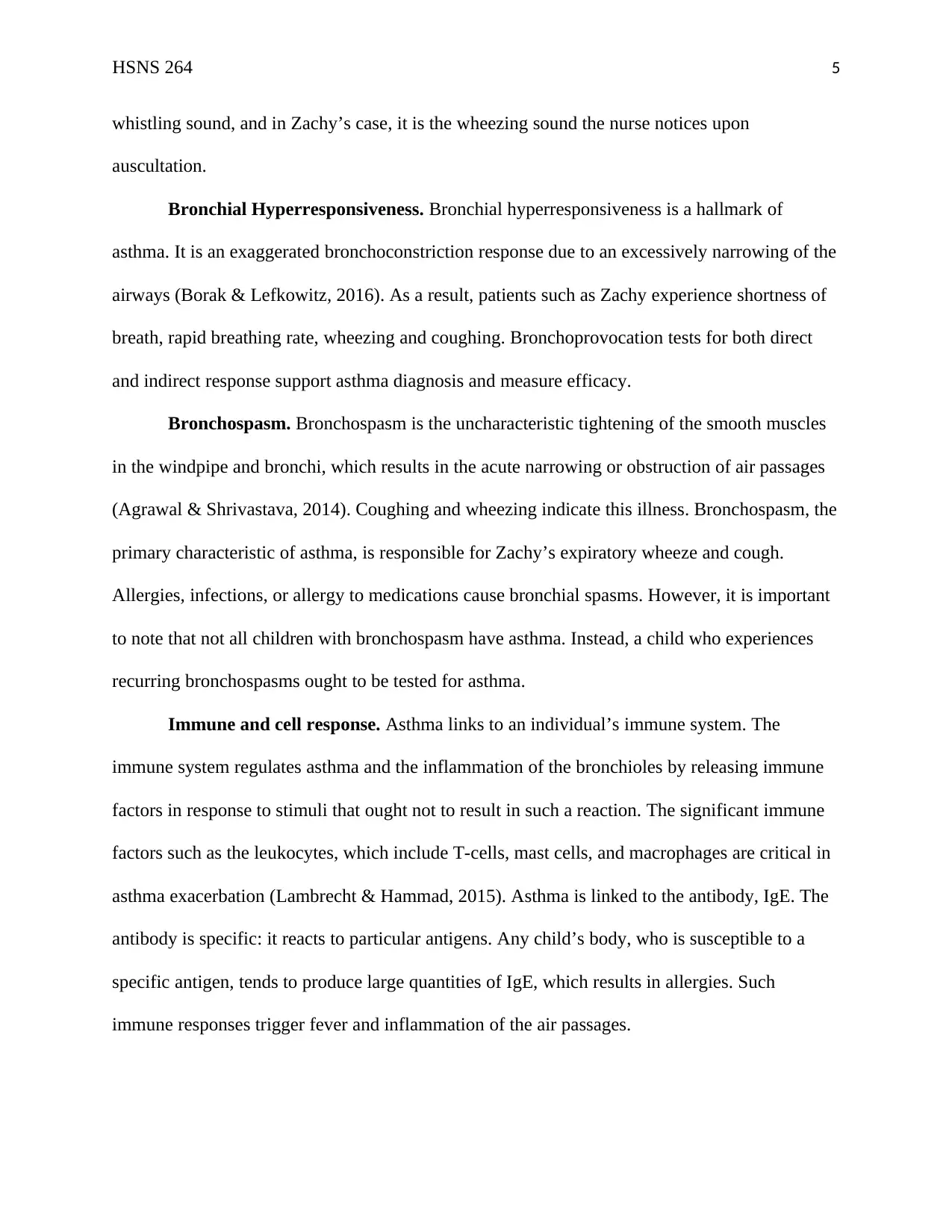
HSNS 264 5
whistling sound, and in Zachy’s case, it is the wheezing sound the nurse notices upon
auscultation.
Bronchial Hyperresponsiveness. Bronchial hyperresponsiveness is a hallmark of
asthma. It is an exaggerated bronchoconstriction response due to an excessively narrowing of the
airways (Borak & Lefkowitz, 2016). As a result, patients such as Zachy experience shortness of
breath, rapid breathing rate, wheezing and coughing. Bronchoprovocation tests for both direct
and indirect response support asthma diagnosis and measure efficacy.
Bronchospasm. Bronchospasm is the uncharacteristic tightening of the smooth muscles
in the windpipe and bronchi, which results in the acute narrowing or obstruction of air passages
(Agrawal & Shrivastava, 2014). Coughing and wheezing indicate this illness. Bronchospasm, the
primary characteristic of asthma, is responsible for Zachy’s expiratory wheeze and cough.
Allergies, infections, or allergy to medications cause bronchial spasms. However, it is important
to note that not all children with bronchospasm have asthma. Instead, a child who experiences
recurring bronchospasms ought to be tested for asthma.
Immune and cell response. Asthma links to an individual’s immune system. The
immune system regulates asthma and the inflammation of the bronchioles by releasing immune
factors in response to stimuli that ought not to result in such a reaction. The significant immune
factors such as the leukocytes, which include T-cells, mast cells, and macrophages are critical in
asthma exacerbation (Lambrecht & Hammad, 2015). Asthma is linked to the antibody, IgE. The
antibody is specific: it reacts to particular antigens. Any child’s body, who is susceptible to a
specific antigen, tends to produce large quantities of IgE, which results in allergies. Such
immune responses trigger fever and inflammation of the air passages.
whistling sound, and in Zachy’s case, it is the wheezing sound the nurse notices upon
auscultation.
Bronchial Hyperresponsiveness. Bronchial hyperresponsiveness is a hallmark of
asthma. It is an exaggerated bronchoconstriction response due to an excessively narrowing of the
airways (Borak & Lefkowitz, 2016). As a result, patients such as Zachy experience shortness of
breath, rapid breathing rate, wheezing and coughing. Bronchoprovocation tests for both direct
and indirect response support asthma diagnosis and measure efficacy.
Bronchospasm. Bronchospasm is the uncharacteristic tightening of the smooth muscles
in the windpipe and bronchi, which results in the acute narrowing or obstruction of air passages
(Agrawal & Shrivastava, 2014). Coughing and wheezing indicate this illness. Bronchospasm, the
primary characteristic of asthma, is responsible for Zachy’s expiratory wheeze and cough.
Allergies, infections, or allergy to medications cause bronchial spasms. However, it is important
to note that not all children with bronchospasm have asthma. Instead, a child who experiences
recurring bronchospasms ought to be tested for asthma.
Immune and cell response. Asthma links to an individual’s immune system. The
immune system regulates asthma and the inflammation of the bronchioles by releasing immune
factors in response to stimuli that ought not to result in such a reaction. The significant immune
factors such as the leukocytes, which include T-cells, mast cells, and macrophages are critical in
asthma exacerbation (Lambrecht & Hammad, 2015). Asthma is linked to the antibody, IgE. The
antibody is specific: it reacts to particular antigens. Any child’s body, who is susceptible to a
specific antigen, tends to produce large quantities of IgE, which results in allergies. Such
immune responses trigger fever and inflammation of the air passages.
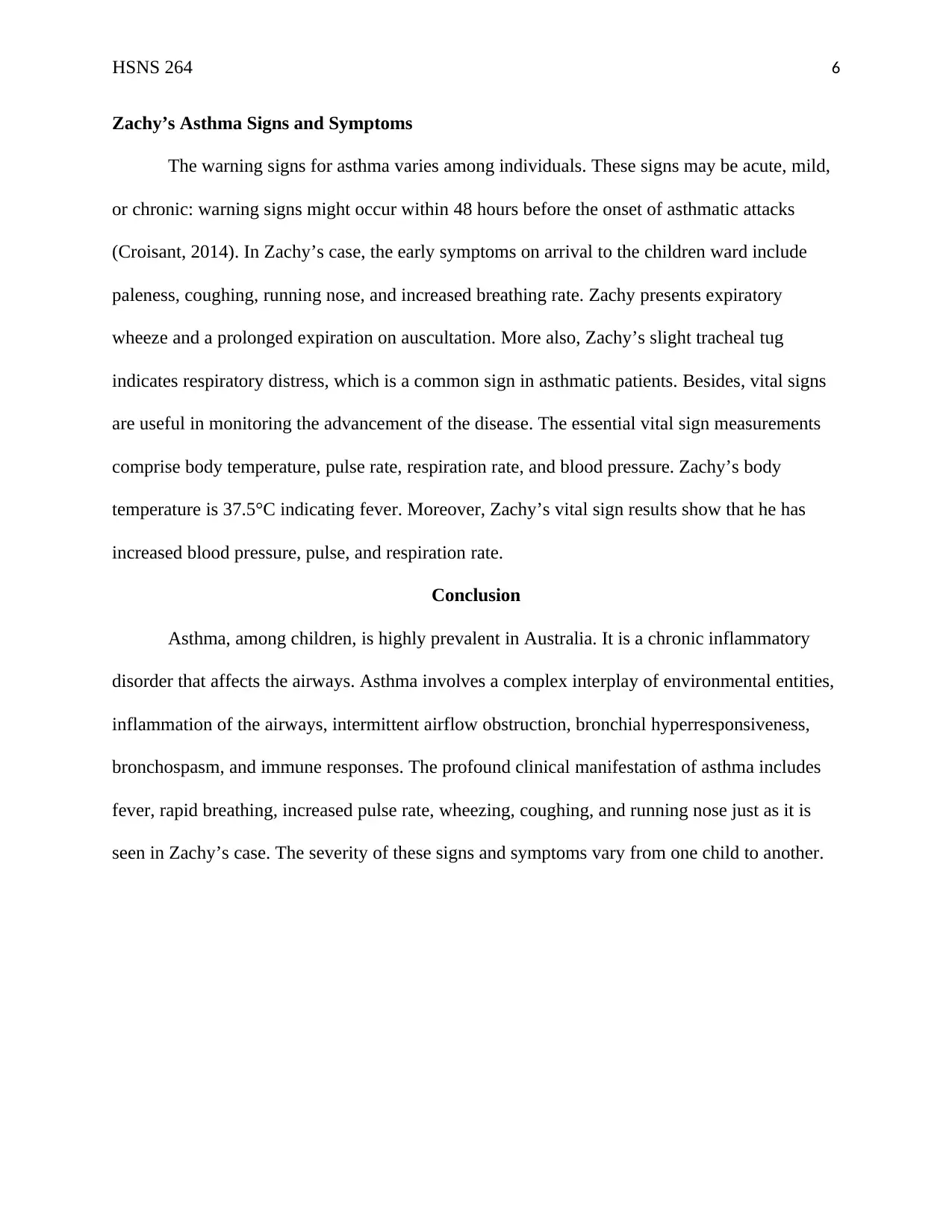
HSNS 264 6
Zachy’s Asthma Signs and Symptoms
The warning signs for asthma varies among individuals. These signs may be acute, mild,
or chronic: warning signs might occur within 48 hours before the onset of asthmatic attacks
(Croisant, 2014). In Zachy’s case, the early symptoms on arrival to the children ward include
paleness, coughing, running nose, and increased breathing rate. Zachy presents expiratory
wheeze and a prolonged expiration on auscultation. More also, Zachy’s slight tracheal tug
indicates respiratory distress, which is a common sign in asthmatic patients. Besides, vital signs
are useful in monitoring the advancement of the disease. The essential vital sign measurements
comprise body temperature, pulse rate, respiration rate, and blood pressure. Zachy’s body
temperature is 37.5°C indicating fever. Moreover, Zachy’s vital sign results show that he has
increased blood pressure, pulse, and respiration rate.
Conclusion
Asthma, among children, is highly prevalent in Australia. It is a chronic inflammatory
disorder that affects the airways. Asthma involves a complex interplay of environmental entities,
inflammation of the airways, intermittent airflow obstruction, bronchial hyperresponsiveness,
bronchospasm, and immune responses. The profound clinical manifestation of asthma includes
fever, rapid breathing, increased pulse rate, wheezing, coughing, and running nose just as it is
seen in Zachy’s case. The severity of these signs and symptoms vary from one child to another.
Zachy’s Asthma Signs and Symptoms
The warning signs for asthma varies among individuals. These signs may be acute, mild,
or chronic: warning signs might occur within 48 hours before the onset of asthmatic attacks
(Croisant, 2014). In Zachy’s case, the early symptoms on arrival to the children ward include
paleness, coughing, running nose, and increased breathing rate. Zachy presents expiratory
wheeze and a prolonged expiration on auscultation. More also, Zachy’s slight tracheal tug
indicates respiratory distress, which is a common sign in asthmatic patients. Besides, vital signs
are useful in monitoring the advancement of the disease. The essential vital sign measurements
comprise body temperature, pulse rate, respiration rate, and blood pressure. Zachy’s body
temperature is 37.5°C indicating fever. Moreover, Zachy’s vital sign results show that he has
increased blood pressure, pulse, and respiration rate.
Conclusion
Asthma, among children, is highly prevalent in Australia. It is a chronic inflammatory
disorder that affects the airways. Asthma involves a complex interplay of environmental entities,
inflammation of the airways, intermittent airflow obstruction, bronchial hyperresponsiveness,
bronchospasm, and immune responses. The profound clinical manifestation of asthma includes
fever, rapid breathing, increased pulse rate, wheezing, coughing, and running nose just as it is
seen in Zachy’s case. The severity of these signs and symptoms vary from one child to another.
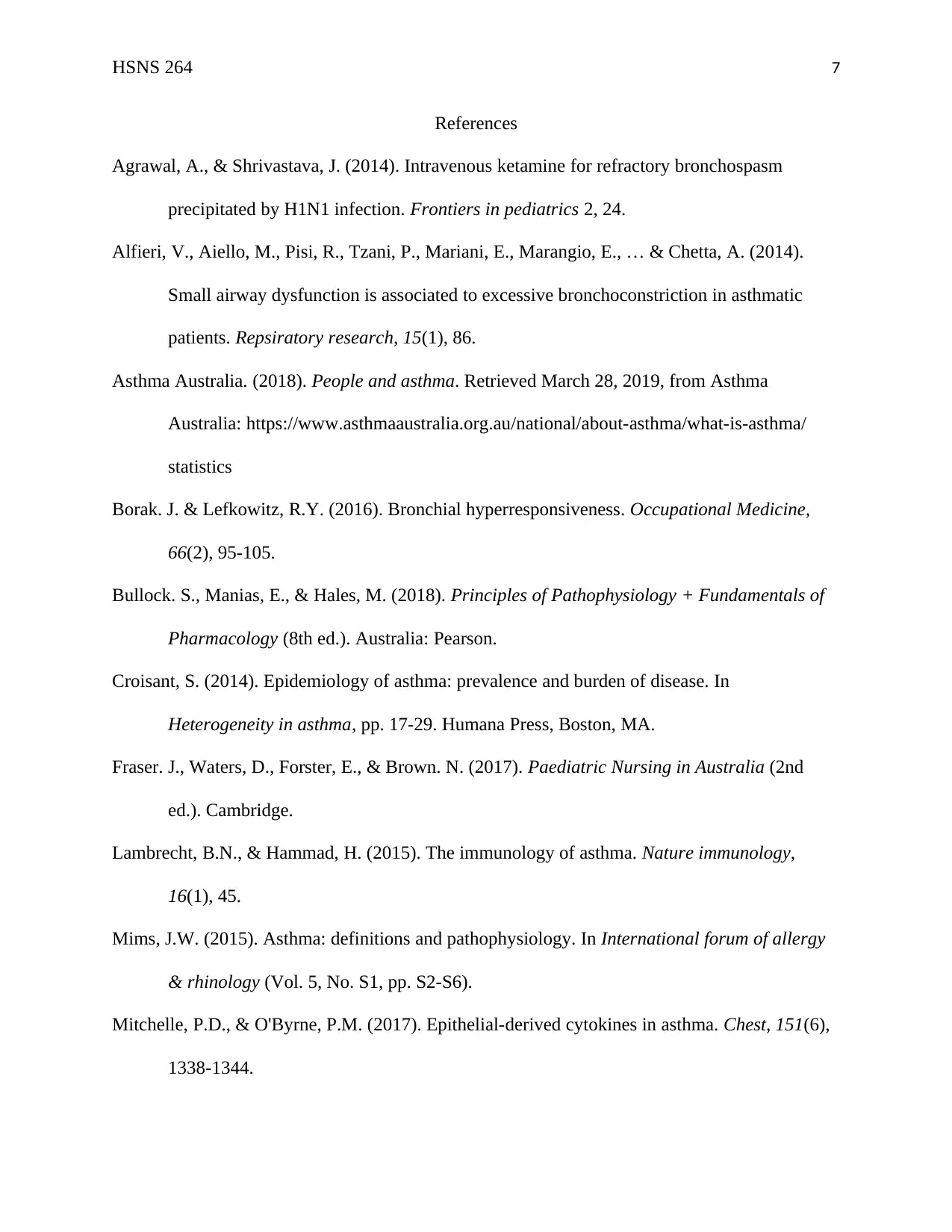
HSNS 264 7
References
Agrawal, A., & Shrivastava, J. (2014). Intravenous ketamine for refractory bronchospasm
precipitated by H1N1 infection. Frontiers in pediatrics 2, 24.
Alfieri, V., Aiello, M., Pisi, R., Tzani, P., Mariani, E., Marangio, E., … & Chetta, A. (2014).
Small airway dysfunction is associated to excessive bronchoconstriction in asthmatic
patients. Repsiratory research, 15(1), 86.
Asthma Australia. (2018). People and asthma. Retrieved March 28, 2019, from Asthma
Australia: https://www.asthmaaustralia.org.au/national/about-asthma/what-is-asthma/
statistics
Borak. J. & Lefkowitz, R.Y. (2016). Bronchial hyperresponsiveness. Occupational Medicine,
66(2), 95-105.
Bullock. S., Manias, E., & Hales, M. (2018). Principles of Pathophysiology + Fundamentals of
Pharmacology (8th ed.). Australia: Pearson.
Croisant, S. (2014). Epidemiology of asthma: prevalence and burden of disease. In
Heterogeneity in asthma, pp. 17-29. Humana Press, Boston, MA.
Fraser. J., Waters, D., Forster, E., & Brown. N. (2017). Paediatric Nursing in Australia (2nd
ed.). Cambridge.
Lambrecht, B.N., & Hammad, H. (2015). The immunology of asthma. Nature immunology,
16(1), 45.
Mims, J.W. (2015). Asthma: definitions and pathophysiology. In International forum of allergy
& rhinology (Vol. 5, No. S1, pp. S2-S6).
Mitchelle, P.D., & O'Byrne, P.M. (2017). Epithelial-derived cytokines in asthma. Chest, 151(6),
1338-1344.
References
Agrawal, A., & Shrivastava, J. (2014). Intravenous ketamine for refractory bronchospasm
precipitated by H1N1 infection. Frontiers in pediatrics 2, 24.
Alfieri, V., Aiello, M., Pisi, R., Tzani, P., Mariani, E., Marangio, E., … & Chetta, A. (2014).
Small airway dysfunction is associated to excessive bronchoconstriction in asthmatic
patients. Repsiratory research, 15(1), 86.
Asthma Australia. (2018). People and asthma. Retrieved March 28, 2019, from Asthma
Australia: https://www.asthmaaustralia.org.au/national/about-asthma/what-is-asthma/
statistics
Borak. J. & Lefkowitz, R.Y. (2016). Bronchial hyperresponsiveness. Occupational Medicine,
66(2), 95-105.
Bullock. S., Manias, E., & Hales, M. (2018). Principles of Pathophysiology + Fundamentals of
Pharmacology (8th ed.). Australia: Pearson.
Croisant, S. (2014). Epidemiology of asthma: prevalence and burden of disease. In
Heterogeneity in asthma, pp. 17-29. Humana Press, Boston, MA.
Fraser. J., Waters, D., Forster, E., & Brown. N. (2017). Paediatric Nursing in Australia (2nd
ed.). Cambridge.
Lambrecht, B.N., & Hammad, H. (2015). The immunology of asthma. Nature immunology,
16(1), 45.
Mims, J.W. (2015). Asthma: definitions and pathophysiology. In International forum of allergy
& rhinology (Vol. 5, No. S1, pp. S2-S6).
Mitchelle, P.D., & O'Byrne, P.M. (2017). Epithelial-derived cytokines in asthma. Chest, 151(6),
1338-1344.
Paraphrase This Document
Need a fresh take? Get an instant paraphrase of this document with our AI Paraphraser

HSNS 264 8
1 out of 8
Related Documents
Your All-in-One AI-Powered Toolkit for Academic Success.
+13062052269
info@desklib.com
Available 24*7 on WhatsApp / Email
![[object Object]](/_next/static/media/star-bottom.7253800d.svg)
Unlock your academic potential
© 2024 | Zucol Services PVT LTD | All rights reserved.





